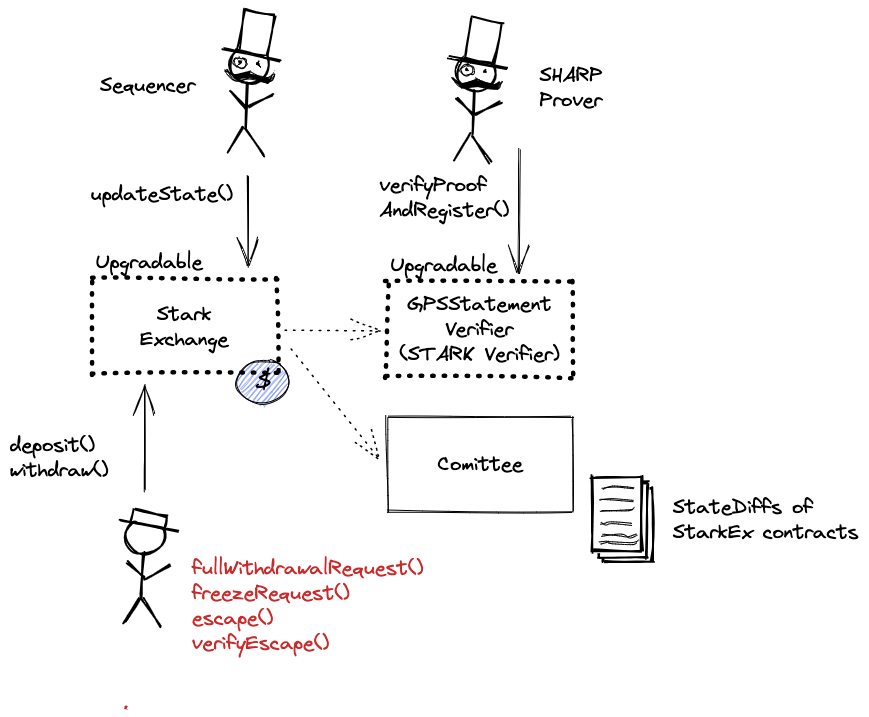Search
Search for projects by name
 Canvas Connect
Canvas Connect
Badges
About
Canvas Connect is a Layer 2 solution based on StarkEx technology, specifically designed to provide centralized investment and trading services to financial institutions.
About
Canvas Connect is a Layer 2 solution based on StarkEx technology, specifically designed to provide centralized investment and trading services to financial institutions.
2023 Feb 01 — 2025 Jul 22
Funds can be stolen if
Funds can be lost if
Users can be censored if
MEV can be extracted if
STARKs are zero knowledge proofs that ensure state correctness.
Proof construction relies fully on data that is NOT published onchain. There exists a Data Availability Committee (DAC) with a threshold of 1/2 that is tasked with protecting and supplying the data.
There is no window for users to exit in case of an unwanted regular upgrade since contracts are instantly upgradable.
Users are able to trustlessly exit by submitting a Merkle proof of funds. NFTs will be minted on L1 to exit.
Data is not stored on chain
The balances of the users are not published onchain, but rather sent to external trusted parties, also known as committee members. A state update is valid and accepted onchain only if at least a quorum of the committee members sign a state update.
Funds can be lost if the external data becomes unavailable (CRITICAL).
Users can be censored if the committee restricts their access to the external data.
Each update to the system state must be accompanied by a ZK proof that ensures that the new state was derived by correctly applying a series of valid user transactions to the previous state. These proofs are then verified on Ethereum by a smart contract. The system state is represented using Merkle roots.
The system has a centralized operator
The operator is the only entity that can propose blocks. A live and trustworthy operator is vital to the health of the system. Typically, the Operator is the hot wallet of the StarkEx service submitting state updates for which proofs have been already submitted and verified.
MEV can be extracted if the operator exploits their centralized position and frontruns user transactions.
Users can force exit the system
Force exit allows the users to escape censorship by withdrawing their funds. The system allows users to force the withdrawal of funds by submitting a request directly to the contract onchain. The request must be served within a defined time period. If this does not happen, the system will halt regular operation and permit trustless withdrawal of funds.
Users can be censored if the operator refuses to include their transactions. However, there exists a mechanism to independently exit the system.
Regular exit
The user initiates the withdrawal by submitting a regular transaction on this chain. When the block containing that transaction is settled the funds become available for withdrawal on L1.ZK proofs are required to settle blocks. Finally the user submits an L1 transaction to claim the funds. When withdrawing NFTs they are minted on L1.
Forced exit
If the user experiences censorship from the operator with regular exit they can submit their withdrawal requests directly on L1. The system is then obliged to service this request. Once the force operation is submitted and if the request is serviced, the operation follows the flow of a regular exit.
Emergency exit
If the enough time deadline passes and the forced exit is still ignored the user can put the system into a frozen state, disallowing further state updates. In that case everybody can withdraw by submitting a merkle proof of their funds with their L1 transaction.

Ethereum
Roles:
Permissioned to regularly update the state roots of the L2 on L1. Each state update must have been proven via the SHARP verifier and contains commitments to the data that is itself kept offchain.
Actors:
A Multisig with 2/4 threshold.
- Can upgrade with 8d delay
- SHARPVerifierCallProxy - acting directly with 8d delay
- Can upgrade with no delay
- StarkExchange
- Can interact with StarkExchange
- manage the token admin role
- A Governor - acting directly
- Can interact with StarkExchange
- Can regsiter new tokens for deposits and withdrawals


Ethereum
Central Validium contract. Receives (verified) state roots from the Operator, allows users to consume L2 -> L1 messages and send L1 -> L2 messages. Critical configuration values for the L2’s logic are defined here by various governance roles.
- Roles:
- admin: EOA 1
- operators: EOA 2, EOA 4
- tokenAdmins: EOA 3
- This contract stores the following tokens: ETH, USDC.
Data Availability Committee (DAC) contract verifying and storing data availability claims from DAC Members (via a multisignature check). The threshold of valid signatures is 1.
Upgradable call proxy contract through which the SHARPVerifier can be called. A call proxy does not delegatecall and the storage context remains at the target contract. It allows SHARP Multisig to change the otherwise immutable verifier contract with 8d delay.
- Roles:
- admin: SHARP Multisig
Shared Starkware SHARP verifier used collectively by Starknet and other SN stack and StarkEx projects. It receives STARK proofs from the Prover and verifies the integrity of the offchain execution including a correctly computed state root which is part of the Program Output.
Adapter between the core contract and the SHARPVerifierCallProxy. Stores the Cairo programHash (16830627573509542901909952446321116535677491650708854009406762893086223513).
Auxiliary to the SHARPVerifier contract: Verified ‘memory fact pages’ get stored here. This is important as it registers all necessary onchain data produced by the verifier.
Value Secured is calculated based on these smart contracts and tokens:
The current deployment carries some associated risks:
Funds can be stolen if a contract receives a malicious code upgrade. There is no delay on code upgrades (CRITICAL).
